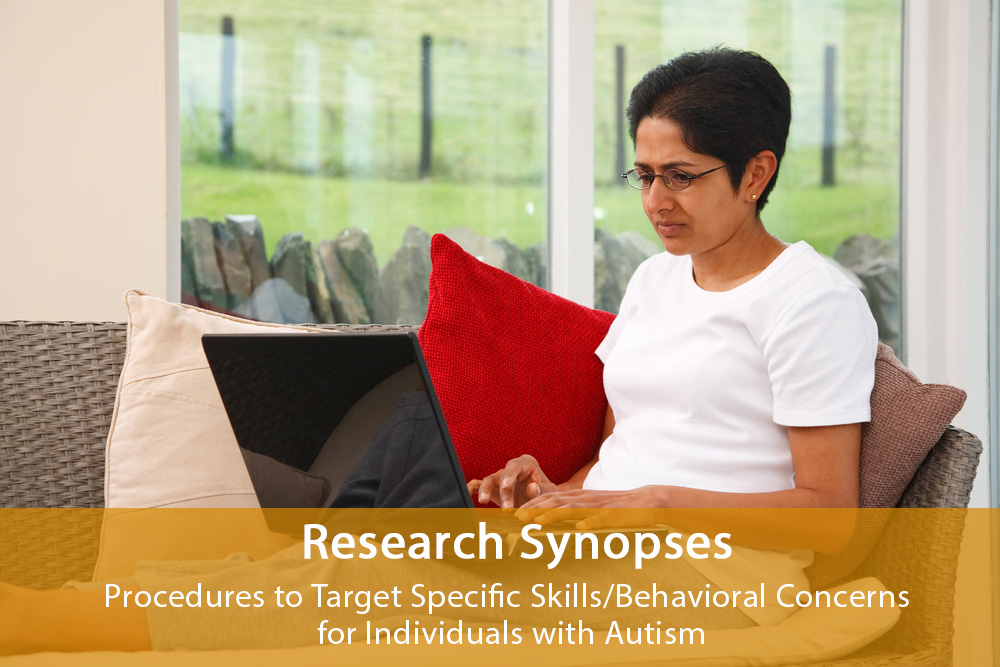Schreibman, L., & Stahmer, A. C. (2014). A randomized trial comparison of the effects of verbal and pictorial naturalistic communication strategies on spoken language for young children with autism. Journal of Autism and Developmental Disorders, 44(5), 1244-1251.
Reviewed by: Mikala Hanson
Rutgers University
Why research this topic?
 In recent years, a number of treatment models have built scientific support for teaching communication skills to children with autism spectrum disorder (ASD). Two commonly used models are Pivotal Response Training (PRT) and the Picture Exchange Communication System (PECS). PRT addresses communication deficits by targeting areas of development like motivation, responsiveness to multiple cues, and social interaction. PECS addresses communication deficits by teaching individuals to exchange picture icons to communicate. Both models provide natural opportunities for communication and use direct reinforcement to increase responding. PRT has been shown to improve speech imitation, labeling, spontaneous speech, and requesting in previously nonverbal children with ASD. PECS has been shown to increase requesting and other kinds of communication in the same population. The present study compared the effectiveness of PRT to PECS on the acquisition of spoken language by young, nonverbal or minimally verbal children with ASD.
In recent years, a number of treatment models have built scientific support for teaching communication skills to children with autism spectrum disorder (ASD). Two commonly used models are Pivotal Response Training (PRT) and the Picture Exchange Communication System (PECS). PRT addresses communication deficits by targeting areas of development like motivation, responsiveness to multiple cues, and social interaction. PECS addresses communication deficits by teaching individuals to exchange picture icons to communicate. Both models provide natural opportunities for communication and use direct reinforcement to increase responding. PRT has been shown to improve speech imitation, labeling, spontaneous speech, and requesting in previously nonverbal children with ASD. PECS has been shown to increase requesting and other kinds of communication in the same population. The present study compared the effectiveness of PRT to PECS on the acquisition of spoken language by young, nonverbal or minimally verbal children with ASD.
What did the researcher do?
Thirty-nine children (ages 2-3) were randomly assigned to PRT or PECS groups. Participants received an average of 247 hours of treatment across groups. During the first 15 weeks, parents participated in two weekly, 2-hour parent education sessions with their child in the laboratory, and children received an additional five 2-hour sessions per week at home. This was followed by eight weeks of one 2-hour parent education session per week and two 2-hour sessions per week in the home. Researchers then measured the child’s spoken language, spoken vocabulary, adaptive communication, and augmentative communication, as well as parent satisfaction in the two interventions.
What did the researchers find?
Results indicated that the children in both the PRT and PECS conditions made gains in spoken communication, and there was no significant difference between the two interventions. On average, children gained approximately 80 spoken words across the 6-month study period. Parents in both groups were satisfied with the intervention and reported progress in their children. However, parents reported PECS to be more difficult to implement in the home.
What are the strengths and limitations of the study?
One of the strengths of the current study is that it adds to the scientific literature on effective strategies for improving communication skills in individuals with ASD. In addition, the study demonstrated that there was no inhibition of spoken language in using either intervention. The primary limitation was that the study lacked a no-treatment control group for the purpose of comparison. Therefore, it could be argued that treatment gains may have been due to development rather than a function of either intervention.
What do the results mean?
The findings suggest that PECS and PRT have comparable levels of effectiveness for facilitating language. However, according to parents, PRT may be preferred because of easier implementation. To tailor interventions more specifically, further research is needed focusing on child characteristics associated with response to these treatment models. Overall, results point to the benefits of using both PRT and PECS to help build communication in young children with ASD who are minimally verbal or nonverbal.
Citation for this article:
Hanson, M. (2017). Research review: An intervention for sensory difficulties in children with autism: A randomized trial. Science in Autism Treatment, 14(1), 30-31.

